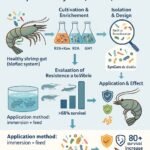
In the realm of the shrimp industry, the choice of the cultivation system can significantly impact disease susceptibility and overall health.
Research has shown that shrimps cultured in a biofloc system (BFS) exhibit a remarkable decrease in disease incidence when compared to their counterparts cultured in a water exchange system (WES).
While previous studies have suggested a link between the gut bacterial community fostered by BFS and shrimp disease resistance, the precise causal relationship remains a mystery.
In a new study published by researchers from Ningbo University, they explored the promotive roles of the gut bacterial community induced by a biofloc system in resisting pathogenic Vibrio infections and the potential microecological and physiological mechanisms at play.
The Role of Intestinal Microbiota
The biofloc system not only offers an ecological approach but also serves as a sanctuary for a stable and resistant gut bacterial community.
BFS increases the relative abundances of taxa such as Rhodobacteraceae, Flavobacteriaceae, and Microbacteriaceae in both water samples and shrimp intestines, while decreasing the relative abundances of bacteria like Vibrionaceae, Pseudoalteromonadaceae, and Pseudomonadaceae.
According to the study’s results, the relative abundances of Ruegeria, Paracoccus, Microbacterium, Demequina, and Tenacibaculum were significantly enriched in the biofloc system. These bacteria play a fundamental role in improving shrimp health and disease resistance.
Transplantation and the Enriching Power of BFS
To understand the profound impact of the gut microbiota from BFS, researchers conducted transplantation experiments. Initially, they cultivated shrimp postlarvae in both biofloc and water exchange systems, and then the animals were infected with pathogenic Vibrio parahaemolyticus.
Stay Always Informed
Join our communities to instantly receive the most important news, reports, and analysis from the aquaculture industry.
The transplantation of a gut bacterial consortium from BFS shrimp, aptly named EnrichBFS, resulted in a notable improvement in the stability of the bacterial community and increased resistance against pathogenic Vibrio parahaemolyticus infection in WES shrimp.
Conversely, the transplantation of a gut bacterial consortium from WES shrimp altered the bacterial community and elevated susceptibility to pathogens in both WES and BFS shrimps.
These findings underline the crucial role of the gut microbiota in shaping shrimp health and disease resistance.
SynComBFS: A Path to Shrimp Prosperity
Isolating and understanding the strains of the five beneficial bacterial taxa enriched in BFS shrimps led to the creation of a synthetic community known as SynComBFS.
The addition of SynComBFS not only suppressed disease development but also improved shrimp growth, boosted digestive and immune activities, and restored health in diseased shrimps. Most intriguingly, SynComBFS strains proved adept at colonizing the shrimp gut, maintaining a high stability of the bacterial community, and ensuring long-lasting benefits.
Conclusive Insights
The research findings shed light on the integral role played by native microbiota in protecting shrimp from bacterial pathogens. Beyond this, they open doors to a microecological regulation strategy that could revolutionize the development of probiotics for aquatic animal diseases.
As the shrimp industry continues to evolve, optimizing the gut microbiota through the adoption of biofloc systems and synthetic communities emerges as a promising avenue to boost shrimp health and reduce disease susceptibility.
Conclusion
“Our study reveals an important role for native microbiota in protecting shrimp from bacterial pathogens and provides a micro-ecological regulation strategy towards the development of probiotics to ameliorate aquatic animal diseases,” concluded the scientists.
They report that the biofloc system can induce the assembly of a beneficial bacterial consortium, which enhances the stability and resistance of the gut bacterial community, as well as the digestive and immune capabilities of shrimps to improve growth and disease resistance.
The insights gained from this research pave the way for new strategies to enhance shrimp farming practices, maximize yields, and ensure the well-being of these aquatic creatures. So, for those in the aquaculture industry, the future may very well be teeming with healthy, disease-resistant shrimps, thanks to the power of biofloc systems and gut bacteria.
Contact Information
Haipeng Guo
State Key Laboratory for Managing Biotic and Chemical Threats to the Quality and Safety of Agro-Products, Ningbo University, Ningbo, 315211, China
School of Marine Sciences, Ningbo University, Ningbo, 315211, China
Email: guohaipeng@nbu.edu.cn
Demin Zhang
State Key Laboratory for Managing Biotic and Chemical Threats to the Quality and Safety of Agro-Products, Ningbo University, Ningbo, 315211, China
School of Marine Sciences, Ningbo University, Ningbo, 315211, China
Email: zhangdemin@nbu.edu.cn
Reference (open access)
Guo, H., Fu, X., He, J. et al. Gut bacterial consortium enriched in a biofloc system protects shrimp against Vibrio parahaemolyticus infection. Microbiome 11, 230 (2023). https://doi.org/10.1186/s40168-023-01663-2
Editor at the digital magazine AquaHoy. He holds a degree in Aquaculture Biology from the National University of Santa (UNS) and a Master’s degree in Science and Innovation Management from the Polytechnic University of Valencia, with postgraduate diplomas in Business Innovation and Innovation Management. He possesses extensive experience in the aquaculture and fisheries sector, having led the Fisheries Innovation Unit of the National Program for Innovation in Fisheries and Aquaculture (PNIPA). He has served as a senior consultant in technology watch, an innovation project formulator and advisor, and a lecturer at UNS. He is a member of the Peruvian College of Biologists and was recognized by the World Aquaculture Society (WAS) in 2016 for his contribution to aquaculture.




